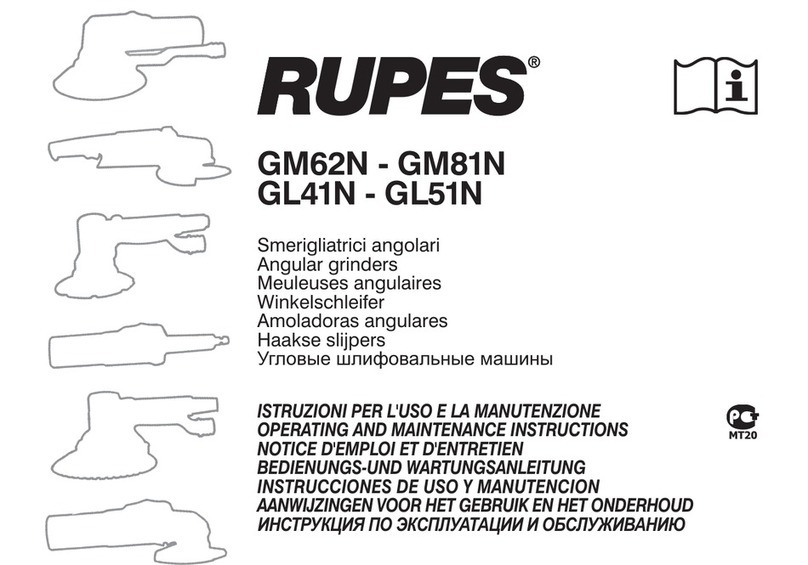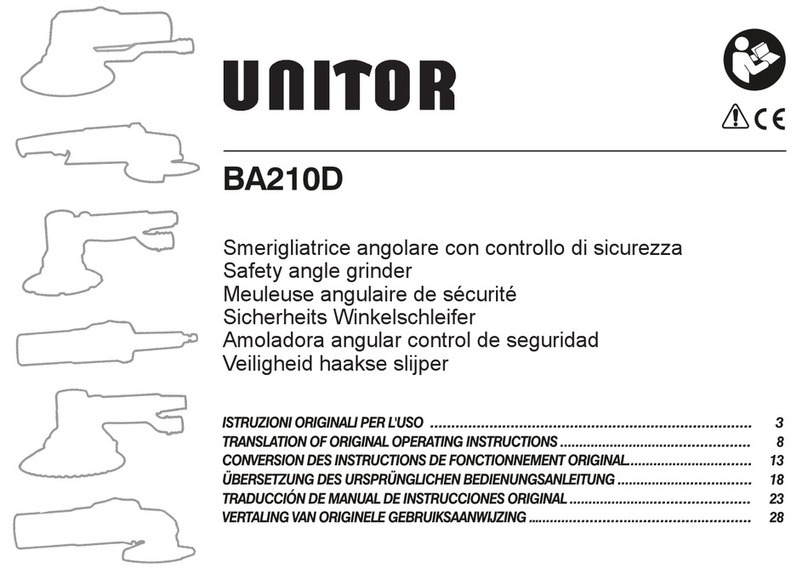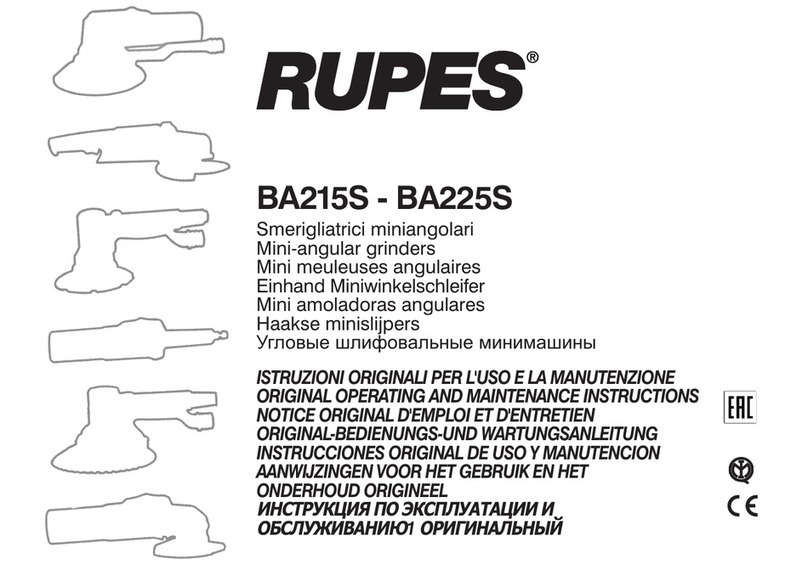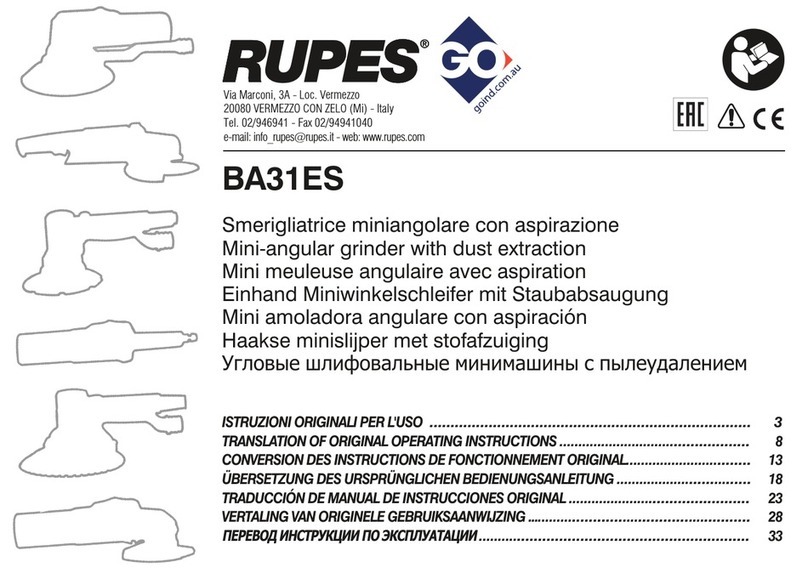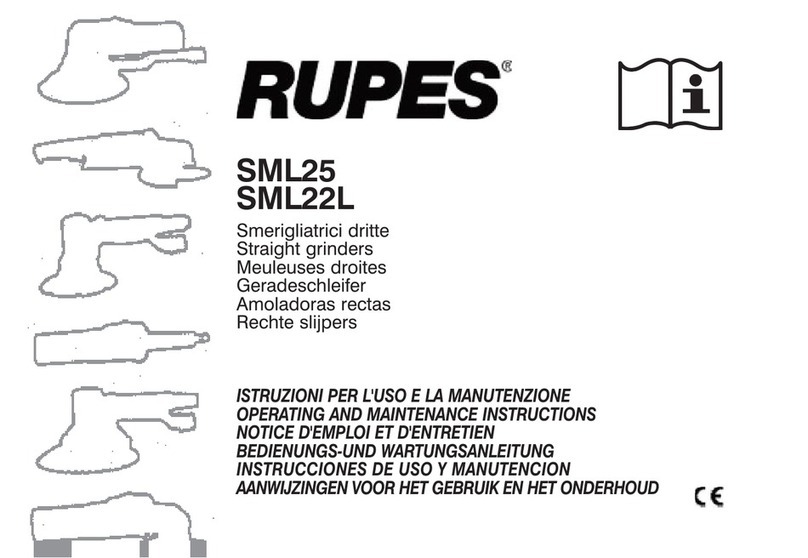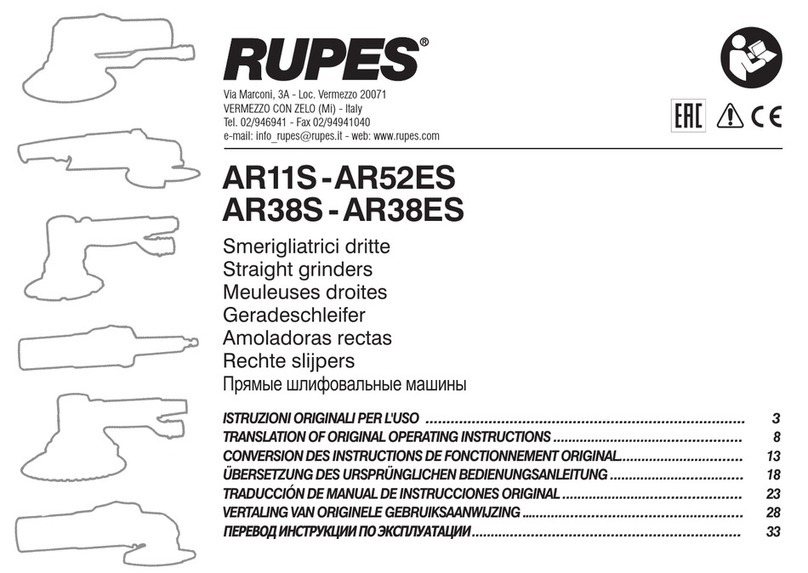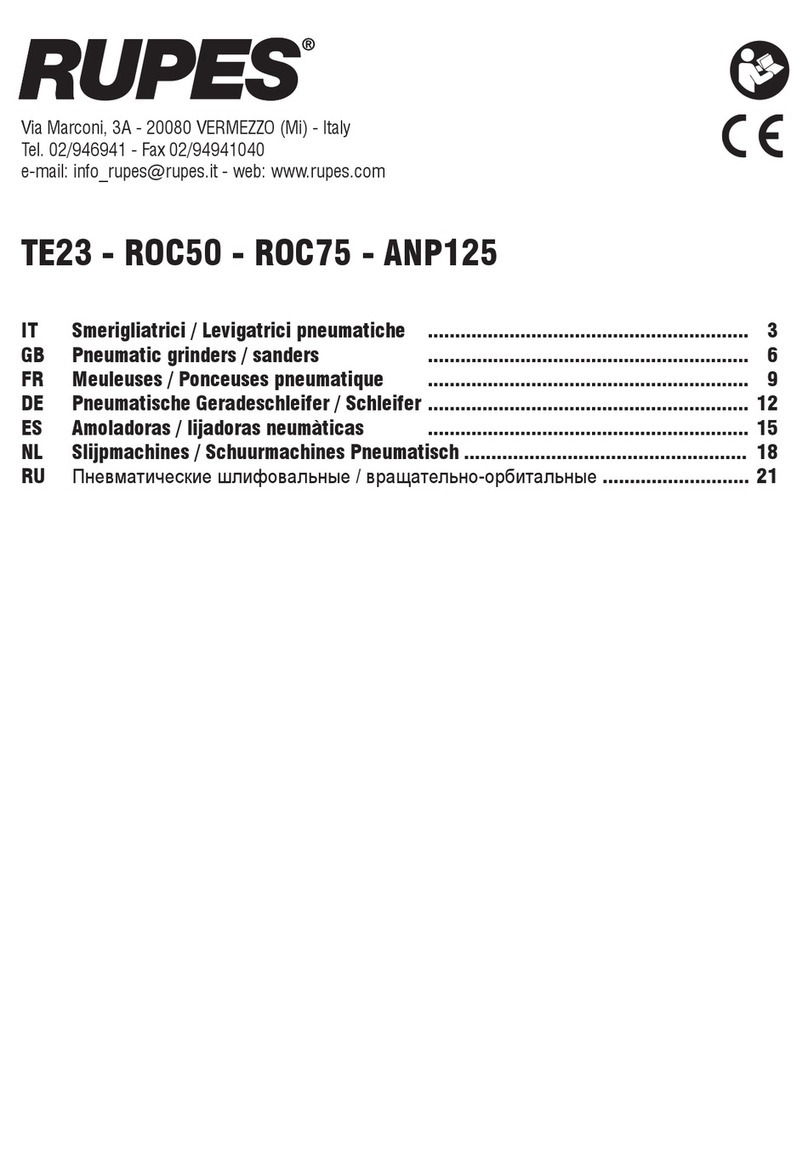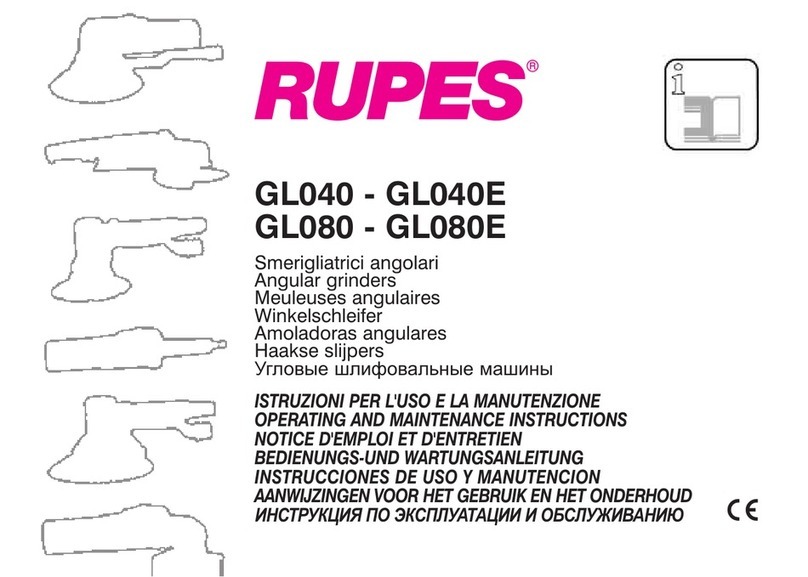5
AVVERTENZEDI SICUREZZA SPECIFICHE PER LE OPERAZIONI DI MOLATURA E
DI TAGLIO ABRASIVO
Utilizzare unicamente tipi di mola consigliati per il vostro utensile e la protezione spe-
cifica concepita per la mola scelta. Le mole per le quali non è stato concepito l’utensile
non possono essere protette in modo soddisfacente e non sono sicure.
La protezione deve essere solidamente fissata all’utensile e messa in posizione di si-
curezza massima, di modo che l’operatore sia esposto il meno possibile alla mola. La
protezione permette di proteggere l’operatore dai frammenti di mola rotta e da un contatto
accidentale con la mola.
Le mole devono essere utilizzate solo per le applicazioni raccomandate. Per esempio:
non smerigliare con il lato della mola da taglio. Le mole abrasive da taglio sono destinate
alla molatura periferica, l’applicazione di forze laterali a queste mole può farle rompere.
Usare sempre flange per mola non danneggiate e che siano di dimensione e forma
corrette per la mola che avete scelto. Le flange per mola appropriate sorreggono la mola,
riducendo così la possibilità di rottura della mola.
Le flange per mole da taglio possono essere diverse dalle flange per mola da smeri-
gliatura. Non utilizzare mole usate di utensili più grandi. La mola destinata a un utensile
più grande non è adatta a causa delle velocità più elevata di un utensile più piccolo: la mola
può esplodere.
Non “mandare in blocco” la mola da taglio né applicare una pressione eccessiva. Non
tentare di rendere il taglio eccessivamente profondo. Una forte pressione sulla mola au-
menta il carico e la probabilità di torsione o di piegamento della mola nel taglio e la possibi-
lità di contraccolpo o di rottura della mola.
Non mettetevi allineati alla mola in rotazione, neppure dietro di essa. Quando la mola,
nel momento in cui funziona, si allontana dal vostro corpo, l’eventuale contraccolpo può
spingere la mola in rotazione, insieme all’utensile, direttamente verso di voi.
Quando la mola si piega o quando si interrompe il taglio per una qualsiasi ragione,
staccare l’utensile dall’alimentazione e tenerlo immobile sino a che la mola non si sia
completamente fermata. Non cercare mai di togliere la mola da taglio mentre la mola è in
movimento altrimenti potrebbe verificarsi un contraccolpo. Bisogna risalire alle cause del
piegamento della mola e prendere le misure correttive affinché non si verifichi più.
Non riprendere l’operazione di taglio nel pezzo in lavorazione. Lasciare che la mola
raggiunga la sua velocità piena e rientrare con attenzione nel taglio. La mola si può
bloccare, risalire oppure avere un contraccolpo se l’utensile viene riavviato nel pezzo in la-
vorazione.
Prevedere un supporto per i pannelli o per qualsiasi pezzo di grosse dimensioni in la-
vorazione per ridurre al minimo il rischio di incastro e di contraccolpo della mola. I pez-
zi in lavorazione grandi hanno la tendenza a flettersi sotto il loro stesso peso. I supporti de-
vono essere messi sotto il pezzo in lavorazione, vicino alla linea di taglio e vicino al bordo del
pezzo in lavorazione su entrambi i lati della mola.
Siate particolarmente prudenti quando fate un “taglio a tasca” in pareti esistenti o in al-
tre zone senza visibilità. La mola sporgente può tagliare tubi del gas o dell’acqua, cavi elet-
trici o oggetti causando possibili contraccolpi.
PARTI DELLA MACCHINA
1 - Etichetta di identificazione
2 - Interruttore di inserimento-disinserimento
3 - Regolatore di velocità
4 - Albero portapinza di serraggio
5 - Pinza di serraggio
6 - Dado di serraggio pinza
7 - Chiavi di servizio
8 - Feritorie per ventilazione motore
MESSA IN FUNZIONE
Prima di mettere in funzione la macchina accertarsi che:
- l’imballo sia integro e non mostri segni di danneggiamento dovuti a trasporto e magazzi-
naggio;
- la macchina sia completa; controllare che numero e natura dei componenti siano conformi
a quanto riportato sul presente libretto;
- la fonte di energia e le prese di corrente a disposizione possano sopportare il carico indi-
cato in tabella e riportato sulla targhetta di identificazione della macchina il cui facsimile,
con spiegazioni, è riportato a pag. 7.
MONTAGGIO DELLE MOLE O DELLE FRESE
AR11N - AR52EN:
1. Inserire il codolo della mola o della fresa nella sede della pinza (5);
2. mantenendo fermo l’albero portapinza (4) con la chiave in dotazione, serrare il dado di
fissaggio (6);
3. controllare che l’utensile non giri fuori centro.
Qualora si desideri utilizzare gli utensili con gambo di Ø 3 mm, inserire la riduzione pinza for-
nita come accessorio.
Per montare la riduzione:
4. svitare il dado (6);
5. inserire la riduzione pinza;
6. riavvitare il dado e procedere al montaggio degli utensili.
AR38N - AR38EN:
1. Inserire la pinza (cod. 921.131 o cod. 922.131) nel dado (cod. 513.131) ed accertatevi
che sia alloggiata nella sua sede;
2. inserire la fresa nella pinza, facendo attenzione al diametro del gambo che deve essere
uguale al foro della pinza;
3. si consiglia di inserire la fresa nella pinza estraendo la stessa insieme al dado dal-
l’albero porta pinza;
4. serrare il dado, pinza e fresa sull’albero porta pinza (cod. 512.131).
Qualora si desideri utilizzare gli utensili con gambo di Ø 3 mm o Ø 6,35 mm, sostituire la pin-
za in dotazione con quelle aventi la sede prescelta fornite come ricambi.
Per effettuare la sostituzione:
5. svitare il dado (6);
6. sostituire la pinza;
7. riavvitare il dado e procedere al montaggio degli utensili (vedi punto 3).
PRIMA DELLA MESSA IN SERVIZIO
Accertarsi che:
- la fonte di energia sia conforme alle caratteristiche della macchina;
- cavo di alimentazione e relativa spina siano in perfetto stato;
- l'interruttore di inserimento/disinserimento sia efficiente operando, però, a spina disinseri-
ta;
- tutti i componenti della macchina siano montati correttamente e non presentino segni di
danneggiamento;
- le feritoie di ventilazione non siano ostruite.






